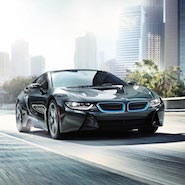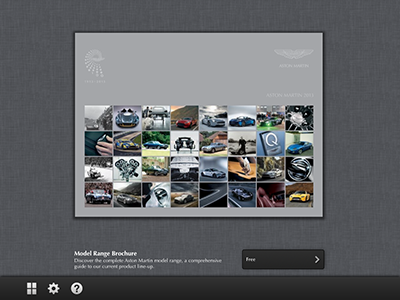 BMW i8
BMW i8
Even as digital mounts a speedy takeover of the marketplace at various points of the purchase journey, brochures still have a place in the automotive world, according to a Foresight Research Study.
A brochure influenced the same proportion of buyers in 2015 as in 2008, and the same percentage preferred to pick one up in person as opposed to finding it online. Understanding the significance of what may seem to be an outdated marketing tool can help brands reach consumers.
“New auto buyers are older and tend to be upscale,” said Nancy Walter, vice president business development at Foresight Research. “Both of those groups are significantly more likely to have looked at a brochure in the year before purchasing their vehicle.
“In addition, the boomers are influenced by fewer marketing channels then are younger buyers, so brochures are a more important part of the mix for a majority of buyers," she said.
Not dead yet
Picking up a catalog at a dealership used to be a staple of shopping for a new car, but that is no longer the case. Today, consumers are free to look at features, specs, colors and accessories for a brand’s entire line online without having to visit the dealership of each brand.
Nonetheless, brochures influence one third of new auto buyers to purchase, a number that matches Foresight’s finding in 2008. Moreover, print copies of brochures picked up at the dealership are still preferred to those found online and even at audio shows, whether or not the consumer says to brochure influenced them in person.
 Aston Martin brochure app
This is partially due to the average age of new car buyers. Economic woes and the migration of youths to urban areas and metropolises has left purchasers of new auto buyers skewing old, with 45 percent being at least 55 years old.
Most important for automakers, however, is that brochures are most popular among influential consumers, defined by Foresight as those who give advice to at least six people about car shopping. They are most likely to recommend their brand to a friend, and they also skew toward luxury purchases, with BMW purchasers being the biggest brochure users.
Dealerships will need to ensure they always have brochures on-hand to reach this desirable consumer subset, and updating the materials in print should be a top priority, not something pushed to the side due to the belief that consumers could find what they need online.
Aston Martin brochure app
This is partially due to the average age of new car buyers. Economic woes and the migration of youths to urban areas and metropolises has left purchasers of new auto buyers skewing old, with 45 percent being at least 55 years old.
Most important for automakers, however, is that brochures are most popular among influential consumers, defined by Foresight as those who give advice to at least six people about car shopping. They are most likely to recommend their brand to a friend, and they also skew toward luxury purchases, with BMW purchasers being the biggest brochure users.
Dealerships will need to ensure they always have brochures on-hand to reach this desirable consumer subset, and updating the materials in print should be a top priority, not something pushed to the side due to the belief that consumers could find what they need online.
 Aston Martin brochure app
Beyond information, Foresight also found that brochures communicate messages about style and brand reputation, not just technical information. Overall, they rank in the top three marketing channels for 15 or 27 messaging themes the researcher studied.
“We actually would have expected them to move over the past eight years, but brochures have held stable in exposure and influence,” Ms. Walter said. “Millennials are generally more open to digital channels, so as that group eventually becomes the majority of new auto buyers, we may see the shift to digital brochure, but auto marketers would benefit from keeping physical catalogs available for the near future.”
Growing up digital
While brochures will remain important for an influential market segment in the near-term, the longer-term outlook across all segments looks quite different.
Multichannel retailing is the future of the automotive industry, with 50 to 60 percent of sales leads expected to come through digital means by 2016, compared to 15 percent in 2014, according to a new report by Frost & Sullivan.
New store formats, such as digital showrooms and pop-ups, offer original equipment manufacturers (OEMs) a cost-effective way to reach consumers and generate sales, but this change in retail strategy requires investment from brands. As automakers alter the way in which consumers interact with their brand during the purchase path and post-purchase, the challenge will be to retain a sense of consistency and loyalty (see story).
Some brands are already positioning themselves for younger, more digitally attuned audiences.
For example, British automaker Rolls-Royce Motor Cars is repositioning itself for consumers with a new Web site.
The new site is designed with mobile in mind, with a smooth flow of images and bold links adorning the homepage. The redesign is a part of Rolls-Royce’s ongoing effort to become more visible in the digital space and to efficiently reach its target market (see story).
"Dealers and automakers will be best served by making brochures available and using messaging in the brochures that expands beyond the technical specs information,” Ms. Walter said.
“This is particularly important when the audience is luxury buyers, as they are the most likely to have read a brochure in the year before purchase, and to have been influenced by brochures," she said.
Aston Martin brochure app
Beyond information, Foresight also found that brochures communicate messages about style and brand reputation, not just technical information. Overall, they rank in the top three marketing channels for 15 or 27 messaging themes the researcher studied.
“We actually would have expected them to move over the past eight years, but brochures have held stable in exposure and influence,” Ms. Walter said. “Millennials are generally more open to digital channels, so as that group eventually becomes the majority of new auto buyers, we may see the shift to digital brochure, but auto marketers would benefit from keeping physical catalogs available for the near future.”
Growing up digital
While brochures will remain important for an influential market segment in the near-term, the longer-term outlook across all segments looks quite different.
Multichannel retailing is the future of the automotive industry, with 50 to 60 percent of sales leads expected to come through digital means by 2016, compared to 15 percent in 2014, according to a new report by Frost & Sullivan.
New store formats, such as digital showrooms and pop-ups, offer original equipment manufacturers (OEMs) a cost-effective way to reach consumers and generate sales, but this change in retail strategy requires investment from brands. As automakers alter the way in which consumers interact with their brand during the purchase path and post-purchase, the challenge will be to retain a sense of consistency and loyalty (see story).
Some brands are already positioning themselves for younger, more digitally attuned audiences.
For example, British automaker Rolls-Royce Motor Cars is repositioning itself for consumers with a new Web site.
The new site is designed with mobile in mind, with a smooth flow of images and bold links adorning the homepage. The redesign is a part of Rolls-Royce’s ongoing effort to become more visible in the digital space and to efficiently reach its target market (see story).
"Dealers and automakers will be best served by making brochures available and using messaging in the brochures that expands beyond the technical specs information,” Ms. Walter said.
“This is particularly important when the audience is luxury buyers, as they are the most likely to have read a brochure in the year before purchase, and to have been influenced by brochures," she said.
